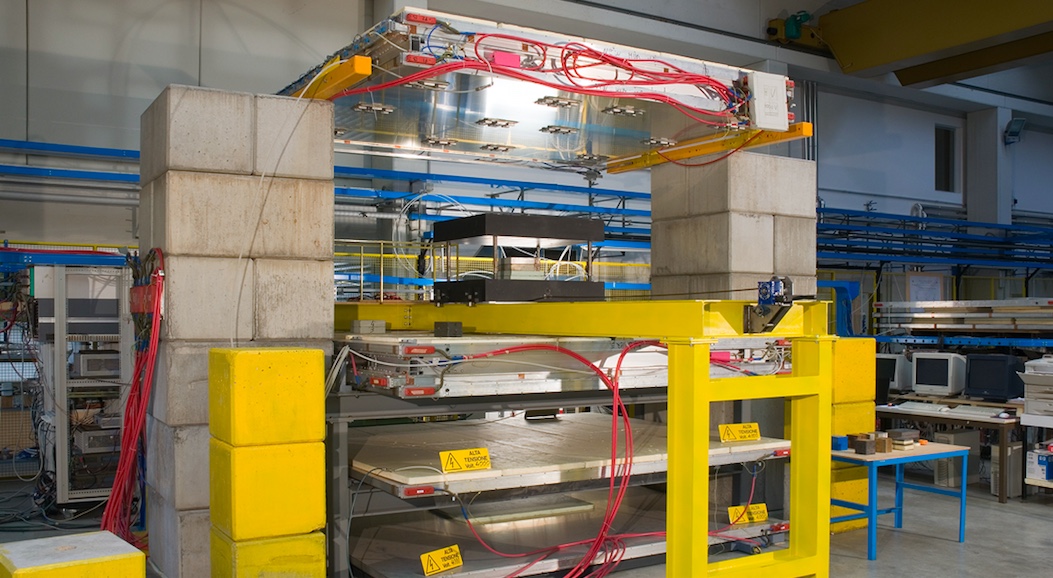 Recreating a 3D density map of nuclear spent fuel assemblies in shielded casks by using a technology developed from particle physics and in total safety is the task of the MuTomCa (MUon TOmography for shielded CAsks) project. In Europe, there are currently around 1500 casks to which this technology could be applied. It implies the construction of a muon detector (muons are particles similar to electrons but with a mass about 200 times higher), capable of showing the interior of the shielded casks including the spent fuel assemblies in a very precise tomographic image while operating from the outside.
Recreating a 3D density map of nuclear spent fuel assemblies in shielded casks by using a technology developed from particle physics and in total safety is the task of the MuTomCa (MUon TOmography for shielded CAsks) project. In Europe, there are currently around 1500 casks to which this technology could be applied. It implies the construction of a muon detector (muons are particles similar to electrons but with a mass about 200 times higher), capable of showing the interior of the shielded casks including the spent fuel assemblies in a very precise tomographic image while operating from the outside.
The project is an international collaboration among the National Institute for Nuclear Physics (INFN; Italy), the Jülich Research Center (FZJ;Germany), BGZ Company for Interim Storage (BGZ Gesellschaft für Zwischenlagerung mbH (BGZ; Germany)) and the European Atomic Energy Community (EURATOM).
Currently, no sufficiently precise method is available for a re-verification of spent fuel assemblies enclosed in thick-walled strongly shielded casks, where the inner fuel assemblies are mostly inaccessible to neutron and gamma ray detection as they are masked by the outer spent fuel assemblies. The relevance of this issue will increase with phasing out nuclear energy production in case that no on-site installation will be available to open spent fuel casks for re-verification purposes in the event that all Safeguards-related containment and surveillance measures fail.
Muon tomography is a technique that uses particles produced when cosmic rays coming from space interact with the earth's atmosphere, the muons, to reconstruct an image of the internal structure of even a very large object. While X-rays, used in radiographs, cannot cross more than a few tens of centimeters, muons can pass through large thicknesses/layers of material, even a few kilometers. This characteristic allows the use of these particles to create three-dimensional images of large structures from the outside and in complete safety.
The detector
A research team led by physicists from the Padua division of INFN, which also includes associates from Genoa and Pavia, is working on the construction of a muon detector based on "drift tube" technology. This technology is often used to detect charged particles and it is used in the muon detectors of the LHC accelerator experiments at CERN, where it made a fundamental contribution, for example, to the discovery of the Higgs boson.
Once completed, the detector will consist of two modules, each 4.5 meters high with a base of 1.5 meter and weight of nearly 1 ton. Inside each module, there are six layers of 30 or 31 drift tubes that are made of an aluminium tube of 5 cm diameter and filled with a particular mixture of gas. Each tube is equipped with a thin copper and beryllium wire in the centre placed at a voltage of 3000 V. As the cosmic muons pass, the detector is able to measure their position and direction with extreme precision, and based on these data it is possible to reconstruct the internal image of the structure to be analysed. The construction and assembly phase, in progress in Italy, will last about one year while the test phase will take place in Germany and will last about six months.
The applications of muon tomography
The first application of this technology dates back to the late 1960s when, during an archaeological mission in Egypt, muon detectors were installed in the pyramid of Chephren, in the Giza plateau, to investigate if there were other unknown chambers inside. At the time, no others were found. Recently (2017) instead, studying the pyramid of Cheops, the presence of a new unknown chamber was discovered. The most recent applications of muon radiography refer, in particular, to volcanoes. By installing a detector at the base, it is possible, in fact, to have information on the internal structure, in particular on the volcanic duct, which has a density different from the rock surroundings so that it is clearly visible in the image. Other applications of technologies related to cosmic muons can be found in the controls of means of transport to counteract nuclear smuggling in industrial applications to avoid accidents due to melting of radioactive sources in foundries and for the optimization of the cycle of blast furnaces. Moreover, the same technology could be used to study other types of nuclear waste stored in the past decades in concrete containers that need to be secured.






